by Dave Arnold
If you hate things that are awesome stop reading now.
If you are still reading: do whatever it takes to get to the Fruit and Spice Park in Homestead Florida, an hour south of Miami. South-Dade is the Mecca for tropical fruits in the continental US, and the Fruit and Spice Park is the public park where you can sample a bajillion of them.
I discovered the park in February when Chris Young (of Modernist Cuisine fame) and I were doing a gig at the South Beach Food and Wine Festival in Miami.
You enter the park through the gift shop, where you’ll find a table filled with whatever fruit the park staff think you should sample. Definitely sample them. If you want to want to eat more while you’re wandering in the orchards, you need to arrange a special guided tour in advance. If you show up unannounced they discourage you from eating fruit off the trees – it is a public park, and if everyone ate fruit off the trees it would be stripped bare lickety-split. Fruit that has fallen on the ground is OK to pilfer, but is often full of bugs (don’t be a wimp –eat around them) or, worse, over-ripe. We had arranged for a special tour and our intrepid guide, Rose Kennedy, picked fruit for us to taste.

Tropical fruit is weird. Forget everything you know about how fruit works –tropicals are different. Some highlights:
Canistel:
The canistel (Pouteria campehiana), which hails from Central America and southern Mexico, is a fruit I can get behind. It is picked hard and then allowed to soften off the tree into a delicious sweet fruit confection. Canistels are very dry as fruits go – similar to an avocado but without oil. The texture is likened by some to cooked egg yolks –a custard of which the canistel’s taste resembles; in fact, the canistel is sometimes called the eggfruit. It makes a fantastic ice cream or sorbet (and doesn’t require added cream). If I had easy access to canistel I would make it into ice cream all the time.

Jaboticaba, Tree Grape:
Jaboticabas (Myrciaria cauliflora, M jaboticaba and other related species) are South American fruits that look like perfectly round grapes but grow on the bark of their trees in a most peculiar way (see the picture at the beginning of the post). There are many named cultivars, but I didn’t keep a record of the ones we sampled (idiot!). Most were delicious –sprightly with a muscadine grape/musky twang to them. One version had a bit of Concord grape flavor. A variety I didn’t favor was more yellow than purple and tasted like sucking on freshly soldered circuit boards.

Sapodilla:
Many tropical fruits don’t change their appearance as they mature. Even more problematic for the picker: fruits of widely differing maturities may be found on the same tree with roughly the same appearance. Half the trick of eating tropical fruits appears to be learning when and how to pick them. Take sapodilla (Manilkara zapota), a fruit of Mexican origin. Immature sapodillas look and feel like mature ones. How do you know when they are ready to pick? Simply scratch the skin with your fingernail. If you see green, leave it where it’s been. If you see yellow-brown, take it down. Many of the sapodillas on the trees we saw showed signs of finger-scratch testing. A mature sapodilla will soften up a couple of days after it is picked.

All the sapodilla cultivars we tasted were extremely sugary – more like brown-sugary. On their own they are sickeningly sweet. The first bite is nice, but the second has to be forced down. Add acid to a sapodilla in the form of lime, however, and you’ll want to eat them by the bushel. Fully ripened sapodillas are soft. Some of the ones we tried were smooth textured and some were a bit grainy, like a pear.
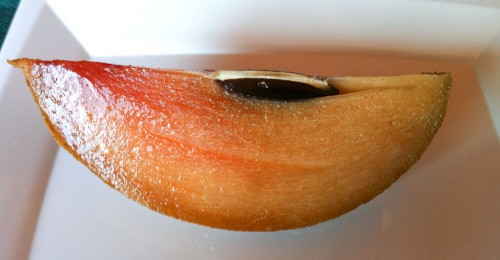
The sapodilla tree and other related species produce chicle, the original chewing gum. People called chicleros make cuts in the tree bark, collect the latex that drips out, and then boil the latex till it reaches the proper consistency – at which point it is known as chicle. Although most modern gum is now made from cheaper synthetic bases, you can still easily get chicle (try www.terraspice.com) and make your own gum — it’s great fun.

Guavas can be Interesting:
It turns out that Guavas, a fruit I had thought was uninteresting and not so tasty, range radically in flavor, size, color, and texture. My previous guava judgment is akin to judging all of apple-dom based on a supermarket Red Delicious. The most interesting guava we tried is the cas (Psidium friedrichsthalianum), a tiny super-tart guava. Your first taste makes you pucker your lips like you were sucking on a lemon –but you are compelled to take a second taste. It would make a most refreshing drink.

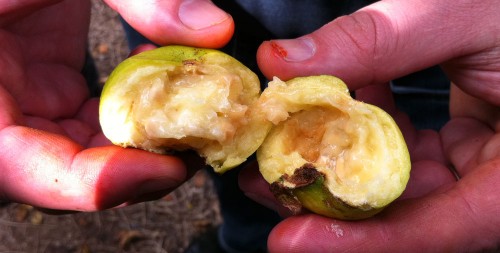
The Much Maligned Starfruit:
Everybody seems to have a tropical fruit they don’t like, and starfruit, or carambola (Averrhoa carambola), is one that most of my chef friends deem useless. Even though carambolas are low on flavor, I find a them quite pleasant: watery, mildy acidic, not hard –yet crunchy. I sampled around ten types of the park’s starfruit to see if there were some butt-kickers I could take home and rub in my buddies’ faces. Sadly, no. While I had some of the best starfruit I have ever had at the park, I tasted no game-changers that I could leverage into a starfruit proselytizing campaign.
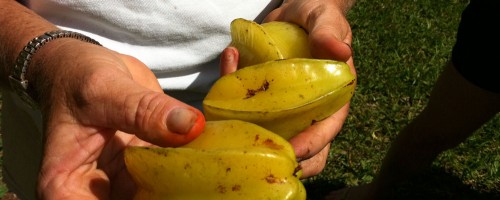
In case you were wondering, I save my tropical-fruit enmity for the dragon fruit (Hylocereus undatus) –one of the showiest fruits in the world. It tastes like crunchy, off-flavored water. Somebody please tell me I’m wrong and send me a good dragon fruit.
A Sapote by any Other Name:
Ask a tropical fruit expert about sapotes and they roll their eyes. Sapote, they will tell you, is a catch-all term for any sweet, roundish fruit from south of the border. You have to specify which sapote you are discussing. Who knew? Well, I want to discuss the black sapote (Diopyros ebenaster), or, as it was described to us, the chocolate pudding fruit. Pick them when they are green and when sepals are starting to pull away from the fruit, and let ‘em soften up a week or so — you’ve got a fruit that tastes like carob pudding. Everyone says chocolate pudding, but to me it tasted more like carob (remember in the 80’s when people were all trying to convince themselves that carob tasted like chocolate?)

Carob or chocolate, this fruit is pretty damn good. As good as the fruit is, the ice cream is better. All you need to do is blend and freeze, nature does the rest. In the Miami area you can purchase a commercially made black sapote ice cream from Gaby’s Farm Tropical Fruits and Ice Creams. I recommend it.

Spices and Leaves and Such:
Fresh allspice leaves (Pimenta dioica). I want them, I need them. They smell like allspice, but fresh and green. Why can’t I buy them in New York? Even more important: Lemon Allspice leaves (aka Lemon Bay Rum, Pimenta racemosus). Why had I never heard of them, and why aren’t they in everybody’s kitchen? A leaf with the aromas of allspice and lemon!
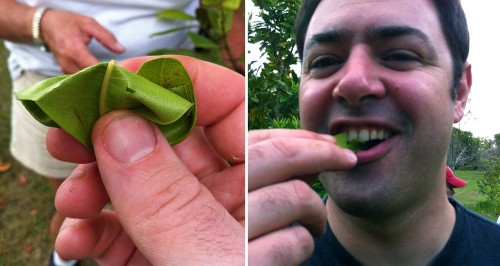
Achiote (aka Annato, Bixa orellana) –the fresh stuff. Beautiful. Don’t know if it tastes any different, but sure is purty.

The Guiana Chestnut (Pachira aquatic) is another cool tree from Cental and South America. The nuts taste somewhat of chestnuts and can by boiled, roasted or fried (yes, I fried mine).

You Have To Keep Going Back
There is no best time to visit the park. There are always some fruits in season, and many trees bear fruit throughout the year in sporadic cycles that are difficult to predict. In the tropics, where there is no killing frost, trees aren’t necessarily tied to annual cycles the way our temperate plants are. The Monstera deliciosa takes over a year to go from flower to mature fruit. The odds that you’ll get to taste one on any particular visit are low.

On our February visit Rose often described the amazing fruit of some tree, how pretty it was, how delicious — and then told us it wasn’t available just then. Salivating, we would ask when it was available, and she would usually say, “oh, you just missed it,” or “oh, in a couple of weeks.” Rose described the product of one sporadic bearer, the ice-cream bean tree (Inga edulis), as a fruit that tasted like cotton-candy-flavored ice cream. From the description, it sounded like a life-changing fruit –a fruit that could launch a thousand ships –a fruit you’d cheat your mom to get. Chris in particular was disappointed he didn’t get to taste it (here is the good news Chris: Nastassia and I tasted it on a later trip: it was good, but I wouldn’t cut off my pinky-toe for regular supply).

While the availability of some fruits are just the luck of the draw, some have definite seasons. The most important of these fruits is the Mango. Mangos are in season only in the summertime. The Park has over 140 mango varieties. I also learned that a couple of miles away from the park lies the Fairchild Farm, a division of the Fairchild Botanical Gardens, with over 400 mango cultivars — the greatest collection of mangos in the country. I love mangos, and who doesn’t? Harold McGee and I had been trying for several years to organize a mango tasting trip to India, one of the centers of mango diversity, but Nastassia and I decided that our first mango-thon should be in Florida. Stay tuned for part 2 of this post: Mango Madness.
Hey Dave, I’m Gonna be near Homestead, but don’t have time for the Park. What Should I Do?
- Rearrange your schedule to make time.
- Visit Robert is Here, a nearby famous fruit stand featuring loads of locally grown tropical fruits.
Hey Dave, I wanna know more. What books should I read on tropical Fruit?
I’m glad you asked.
If you go to the Fruit and Spice Park, purchase their slim guidebook at the gift shop and peruse it before heading outside.

For free reading you can’t beat the online version of Julia F. Morton’s out-of-print classic, Fruits of Warm Climates.
Published in 1987, Fruits of Warm Climates is still considered a go-to book by tropical book enthusiasts. If you want a more comprehensive list of plants, try Margaret Barwick’s Tropical & Subtropical Trees: A World Encyclopedic Guide.
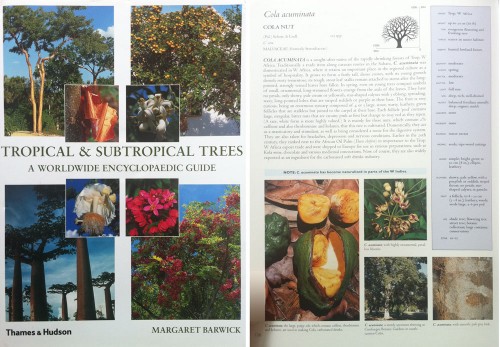
The book is fantastic, but it doesn’t deal exclusively with fruit trees, and focuses on the trees themselves rather than the taste and use of the fruits. Still worth a read.
For the “Completely Useless for a New Yorker but Still Extremely Coveted” award, I present my favorite of the lot: Brazilian Fruits & Cultivated Exotics (for consuming in natura) by Harri Lorenzi, et al. Holy crap. Makes me want to move to Brazil. It contains a brain-busting array of fruits along with taste descriptions, usage, and beautiful shots of the plants and the fruits. By the way, in Brazil, an apple counts as a cultivated exotic but the rare mendubi-guaçu (the red fruit that looks like a flower on the cover) does not.

My wife occasionally tries to stanch the steady stream of new books coming into my small apartment — it must be admitted that the ones I already own are fitted into every crevice like tetris pieces. She agreed that room needed to be made for this book. All the fruits are shot on a crazy blue background with a 1×1 cm grid pattern for scale. As the parenthetical part of the title suggests, this book only deals with fruits that are consumed without preparation. From the preface to the book:
We will not address fruits or parts of fruits that need some type of preparation (cooking, roasting or seasoning), before they can be consumed, like the palm fruit known as pupunha, the pepper, the red sweetsop, the mirliton, pumpkin, Brazilian nightshade (gilo), the cucumber, the olive, the scarlet eggplant, the elephant apple, the Ceylon cinnamon, etc.
Badass. The authors have so many awesome fruits to choose from that they won’t even deign to eat a cucumber raw! The book is hard to find at a reasonable price. I got my copy from a tropical fruit website in Hawaii.
Up next: Mango Madness!


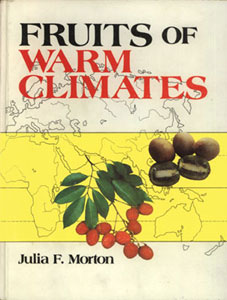
When I was in Vietnam, we had a dragon fruit fruit salad every morning. They served it in cubes, marinated in honey or simple syrup, lemon and fresh ginger – delicious!
Howdy Ole,
I wonder what cultivar they were serving? I don’t even know the name of the standard cultivar we get here in New York. My eldest son got me interested in dragon fruit again because of his “Fruit Ninja” obsession, where the dragon fruit is worth a whopping 50 points (as opposed to most fruits which are worth 1).
I used to occasionally tag along with my wife when she went on business trips to Hong Kong. Every time, I felt compelled to eat the dragon fruit, hoping maybe this time it would be good. Nope. It’s like everything terrible about chocolate covered ants, but nearly tasteless. OTOH, I did eat the heck out of a huge bag of mangosteens whenever I’d go. Which I would gladly give up a toe or two for. I’ve seen them once here in Seattle, but they tasted like heartbreak.
Chuck,
About mangosteens –the ones here in New York are also disappointing, considering that, by all accounts they are worth a toe or two when had fresh. I’ve never had a real one. I hear your neighbors across the border in Vancouver can get good ones that haven’t been treated.
Any chance they had yangmei berries? We bought those by the cartonfull on the streets of Beijing but I’ve never been able to find them in the US. Delicious.
Howdy John,
I just looked on their plant list at http://fruitandspicepark.org/friends/index.php?option=com_content&task=view&id=43&Itemid=29 and didn’t see it. I’ll add it to my mental try list.
Not a tropical fruit… but have you ever tried thimbleberries? They taste like an intense raspberry crossed with a fig. Incredible. They aren’t sold in stores because they do not package well. Worth losing a pinky-toe or even a pinky.
They have them in the germplasm repository in Corvallis OR. Another reason to go.
I have a case of thimbleberry jam in the pantry. 1 part thimbleberry, 1 part sugar, boil for a minute or two and you’re done. Or you can go to Michigan’s upper peninsula, pay exorbitant prices and skip the picking. Someone might even ship if you try hard enough.
For readers from the antipodes, check out the Frosty Mango:
http://www.frostymango.com.au/Frosty_Mango/Fruits.html
Haven’t been there since I was a kid, but the memories are good. I did turn my nose up at black sapote ice-cream though. I was 10 and wanted REAL chocolate ice-cream.
Nice Nick. Next time try the ice cream.
Ever tried a Rollinia? The description is lemon meringue pie but I’d call a lemon pannacotta as closer match that had been made with lemon rind and a touch of citric acid that balances the sweetness which is not over the top. Really addictive fruit when perfectly ripe and a definite tropical only favourite.
Looks cool James. Another one for the list.
While we have no access to fresh jaboticabas up here in Massachusetts, a liqueur made from it is readily available in Cambridge/Somerville due to our large Brazilian population. One bartender used it in a substitution for sweet vermouth in a Negroni with good effect. Decent stuff for $9.99/750 mL.
What is it called?
Liqueur of Jacoticaba. There’s a picture of the bottle and a description of the liqueur and cocktail here:
http://cocktailvirgin.blogspot.com/2011/01/jabuticaba.html
Wow! This sounds like an amazing visit.
I’m glad you tasted jaboticaba! They grow all over here in Brazil, but not a lot of people have them often abroad. If your grandmas back yard didn’t have a jaboticaba tree you didn’t really have a grandma when I was young.
Here you can find jaboticaba port wine, liqueurs and even beer. Some are good some not so much, but if you make jaboticaba liqueur yourself I’m sure you’ll love it!
We’ve done some experimenting and found that the trick to success is to balance how much skin X white part you include. Give it a try.
We have an Achiote Tree at my dad’s but only used it to play as body paint when we where kids. Our native Indians used them to paint their bodies, as dye and in ceremonies. what would you use it for in a bar? (besides coloring)
@ Chuck Mangosteens are fantastic around here. I love them!
On the star fruit issue I have to say that I do like them. They work nicely in a fresh salad with a light sauce and blend very well in cocktails.
I got a fruit shopping guide caller “Fruits you can find in São Paulo†(Frutas que você encontra em São Paulo) a while ago and was amazed at all the variety you can find on retail there that I cant find here in Belo Horizonte. There is not a lot of info in the book and I don’t really recommend it, but it’s useful when wondering our huge distribution centers or exotic fruit markets. I use it mainly to figure out what they name the new stuff I find all the time here.
Have fun on the mango project. To me it’s THE MOST PERFECT fruit.
I need to visit Sao Paulo. I wish I had regular access to all the fruits you guys do. I checked out your website a bit. What do you use the cashew apples for? I’d like a supply of achiote and fresh cacao to make some old-school blood-colored chocolate drinks.
I really like the combination of cashew and fresh herbs like lemon grass and fresh melissa/lemom balm. They really have to be VERY ripe. The sweetness in this fruit is just amazing and i´ve even seen drinks where it pairs well with coffee/chocolate in a very interesting and unusual way. The cashew caipirinha is a must try. Next time they are in season we are going to ferment end distill some into a spirit… let’s see what happens.
Damn! They have some great fruit in the north of Brazil. Cashew, Cacao, Seriguela, Jambo, umbu, umbu-caja, Graviola, Cajá, Mangaba, and so many more…
For some reason it´s never that easy to source fresh cacao at a good price at our distribution centers here in Belo Horizonte. It´s usually grown up north, but it seems there is a gap in the distribution for final consumers for the fresh stuff. Sure you can find it, just not at a great price as other fruits.
What I do many, many times is ask my distributors to save me some of the semi-off cacao they get. They usually have a few brown spots on the outside, but have fine beans (most of the times), this way they turn out free and yield great results.
BTW, try to source some cacao juice if possible, it doesn’t resemble chocolate at all and makes some fine drinks. It can be found frozen.
Cacao is right now my distilling goal, but unlike with the juice, I would love to have the chocolate flavor. Unfortunately as far as I’ve researched and experimented it´s not going to happen without a vacuum. Any thoughts?
Hummm.. I better visit that Achiote tree…
Sorry for the late reply. Ever thought about adding a “subscribe to comments via email†option on the site? I’m sure I’m not the only one interested.
Let me know if you ever come around here, we´ll go for some fruit porn.
Cheers,
Will do. I’ve only distilled chocolate under vacuum, but I’ve had some good stuff from a normal still (At least I think it was).
Is it my imagination or is the blue grid in “Brazilian Fruits” little ceramic tiles? Did this guy put them on his countertop and photo them, using the counter as scale, because that’s pretty awesome.
That would be cool Schenck, but I think these guys carry their blue grid with them wherever they go. The also have a two volume book on trees of Brazil and are coming out with an addendum to fruit.
I love Sapodilla i had it in the virgin islands it taste like cinnamon fruit!!!
If the flavor is bland, you tasted an under ripened dragon fruit. When ripe, they are sweet and sour.
You might want to try a Costa Rica or Yellow. Warning on red flesh (Costa Rica), you might pee red. Don’t freak, it’s just the fruit.
Nishi –peeing red would be a bonus!
Great post! I’m from Palm Beach County, but I never tried any of that! Will you share this on my “What’s in Season?” link party? I’m trying to gather posts from all different places and I don’t have anything from FL. Thanks!! http://nonrecipe.blogspot.com/2011/08/whats-in-season-august-2011.html
Sure, but my next post is a late July Florida post.
LOL, I just read the title again… February. Oh well. I’ll share with my FL friends anyway.
Many of the fruits mentioned in the post are there all the time or sporadically. There is always good stuff at the Park. Your buddies should go no matter what time of year it is!
Wow, those all look mouthwatering. I wonder if it’s possible to genetically engineer tropical plants to grow in non-tropical regions. Is anyone working on this? Come on, Science!
Greenhouses best bet.
What would you do with lemon allspice leaves?
I’d probably end up making some sort of cocktail, but I think they’d be great in stews and soups, as an alternative to bay.
I’d try them out when making Cincinnati-style chili; the allspice would fit right in, and I’m curious to see how the lemon would work.
400 mango varieties! My god! The holy grail!!
Funny about the general disdain for starfruit and guava. I like both. I do a sea scallop crudo (really morelike a ceviche, since they are denatured in white wine and lime juice) with raw starfruit and quick pickled guava, finely brunoised shallot and tarragon oil. It’s gotten me laid a few times, so besides my own personal enjoyment of the dish, I know objectively that it’s good.
I cannot argue with your evidence.
Hey Dave. Totally agree about the dragonfruit. About 12 years ago I saw it on the fruit cart on a business class flight to Taipei and was excited to taste it. I’ve never been so disappointed in my life.
Monstera is a tricky fruit – I’ve bought it when it appears, on rare occasions, in the DC area. I made the mistake of eating the scales once – the segmenty parts attached to the skin do taste delicious and rich-fruity when they pop, but the skin contains some kind of irritant that conveys the sense of eating fiberglass or little shards of glass. I don’t recall ever being in such pain from eating fruit.
Ouch Kitchengrl –those were oxalic acid crystals.
heh. Glad I didn’t pop more than a couple of those scales – hurt like a mofo
I LOVE the sapodilla, in India they’re called mud apples or chiku. I had them every morning with lime juice. Also, the oranges in India are very pink, and the juice is unreal, and they have these tiny sweet and very tender pineapples that I also ate by the lb.
I want tiny sweet pineapples.
I love Sapodilla too! Here in Brazil, we call it Sapoti …and even though its very common in the countryside, its really expensive at the city markets. Makes me very angry. ; /
Thought I’d throw in my experience with the Cas guava. Living with a spanish speaking host family in Costa Rica meant waking up to fresh squeezed juice every morning. Now and again we would get this amazing lime/melon flavored Cas juice. I was obsessed with fruit the whole time I was there but could never buy Cas from any of the fruit markets. I figured it was the language barrier was preventing me from tracking them down until I saw just how much work (and sugar) went into making a pitcher of this stuff. Turns out it wasn’t popular enough to just pop on down to the fruit stand and buy. I miss it though and will have to get myself to the Park next guava season.